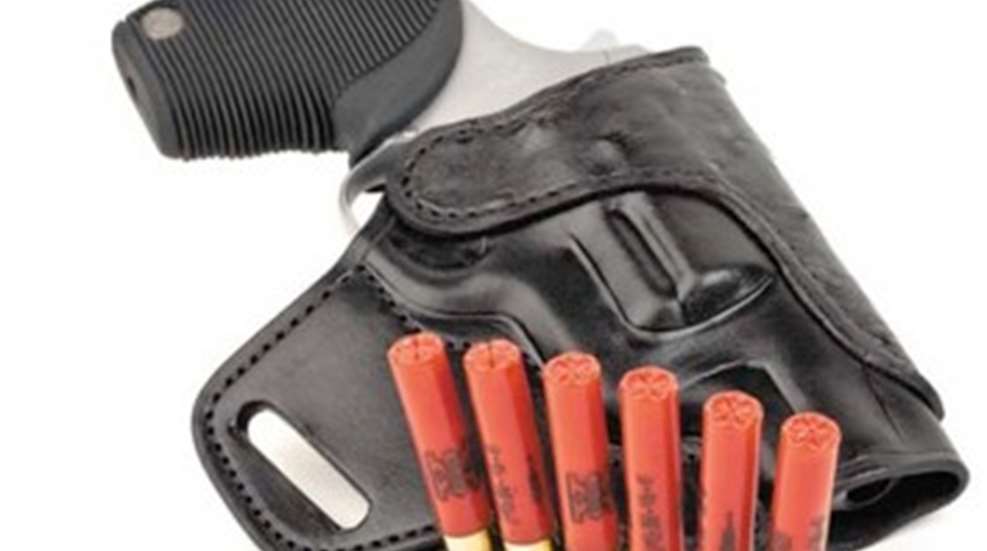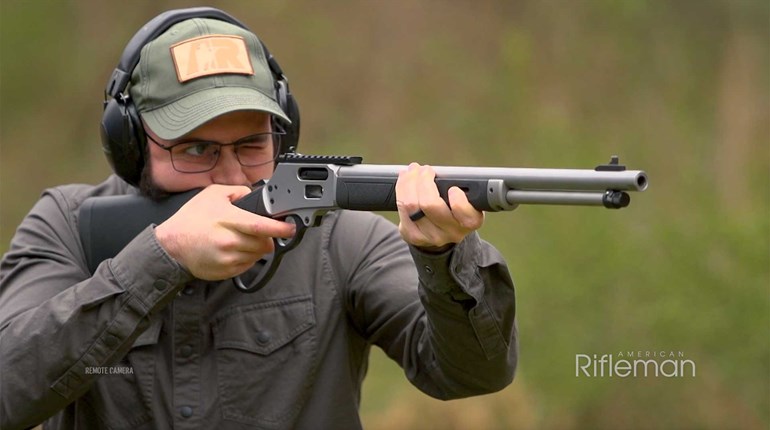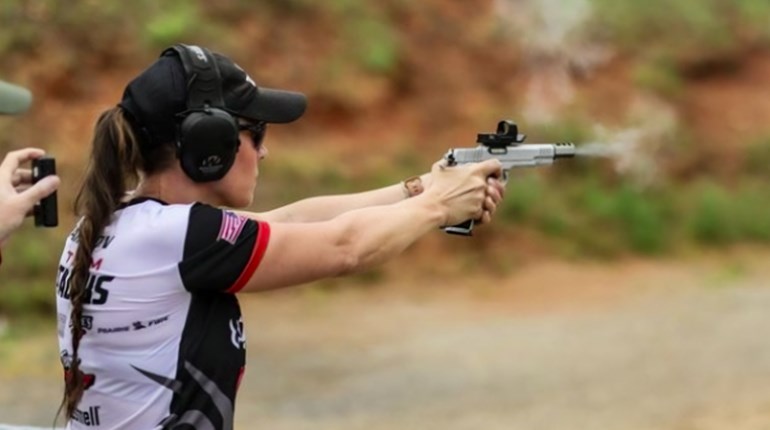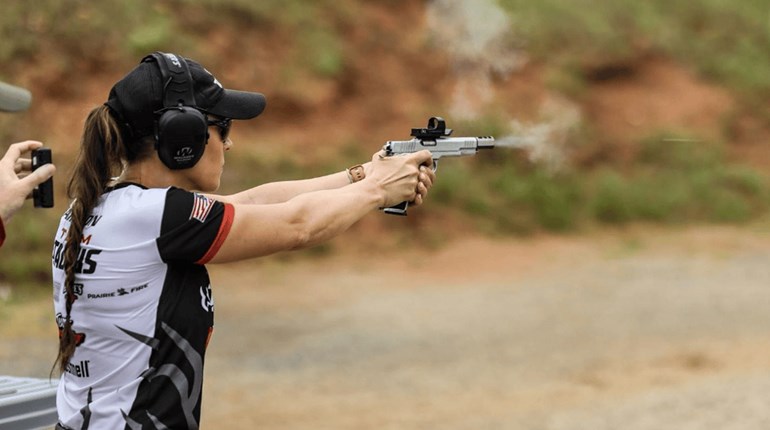
At any given time, chances are good the latest and greatest new concealed-carry gun is a chopped down version of a popular full-sized gun. Downsizing a successful handgun platform is the normal course of evolution in the current market, which craves small handguns. Any dealer's shelves will be full of sub-compact semi-autos and snubby revolvers designed for concealed carry. Now, Taurus has created quite a stir by downsizing the Judge, its immensely popular big-bore revolver, creating the Taurus Judge Public Defender.
The Judge FamilyThe basic concept behind the Judge family of revolvers is simple, yet innovative. The Judge models are five-shot revolvers with a lengthened cylinder to accept standard .410-bore shotgun shells. The real advantage of the shotgun platform, of course, is the variety of ammo choices and the resulting versatility. Judge revolvers will shoot birdshot, buckshot or slugs depending upon the shooter's needs. Furthermore, the same revolvers will chamber and shoot .45 Colt ammunition as well, opening up even more ballistic options.
The first Judge models were part of the Tracker line of revolvers. These are larger guns designed primarily as home-defense or trail guns, and they have been well received. Many experts have touted their effectiveness for self-defense tasks, often as a house or car gun. The leap to concealed carry of Judge revolvers was made difficult by their inherently large size. While some dedicated individuals will carry a full-size, big-bore revolver for self-defense purposes, many simply can or will not.
Compact ConceptTaurus customers campaigned for a smaller Judge revolver, and the company's engineers were tasked with designing a compact model. The Public Defender was the result—a Judge revolver that is specifically tailored for concealed carry and personal defense.
Designed for this new mission, the Public Defender is the smallest offering in Taurus' Judge lineup by far. All exterior dimensions are significantly reduced, including the frame size, barrel length and grip length. The cylinder is limited to 21⁄2-inch shells, the barrel has been shortened to 2 inches and the grip is reduced to the size of a standard Taurus small-frame revolver. These changes amount to a very significant size differential.
The Public Defender has the approximate dimensions of a small-frame snubby revolver, but with a lengthened frame and cylinder that allows it to accommodate .410-bore shells.
The smaller dimensions have reduced the weight of the revolver to a manageable 28 ounces. While this is still heavy in comparison to a lightweight .38 Spl. revolver, it is not out of line for a concealed-carry pistol. With a good, quality holster and gun belt, 28 ounces can be easily carried on an everyday basis. Taurus will soon be offering a version of the Public Defender with a titanium cylinder, further reducing its weight and making it more desirable for those who want something lighter.
Like all Judge models, the Public Defender is a double-action revolver. It has a partially bobbed hammer to reduce any snagging on the draw, but maintains enough surface to permit cocking for single-action use, if needed. In double-action, the trigger pull is heavy, but it is still quite manageable.
The Public Defender has excellent fixed sights. The rear sight is a deep and well-formed notch in the backstrap, while the front sight is a light-gathering fiber optic that is easy to spot in almost any light condition. Target acquisition was easy and fast with the configuration. The nature of the stretched cylinder and frame also creates a longer sight radius than typically found on a short-barreled revolver.
Choices for the CylinderA discussion of the Public Defender would not be complete without a discussion of ammunition choices. While the Judge revolvers are highly regarded for their performance, I was concerned Taurus' choice of a 2-inch barrel might have gone too far in the pursuit of a compact size. After all, the Judge is what essentially amounts to a short-barreled .410 shotgun, so I was concerned the barrel would be too short and would compromise ballistic performance.
The shorter cylinder of the Public Defender means this model will not accept 3-inch magnum .410 shells, but the available shell choices are still impressive. Although snake or varmint control aren't the primary missions of a concealed-carry gun, the Public Defender will shoot a wide variety of birdshot-type shells. Much more interesting in regard to personal defense are .410 shotshells that pack a payload of buckshot. In fact, Federal has developed a load designed specifically for the Judge revolver—the Premium Personal Defense .410 Handgun, with four 000 buckshot pellets, each measuring .36 caliber, which is approximately the diameter of a 9 mm bullet. Winchester also has a new .410 load using a combination of disc projectiles and BB pellets.
The advantage of shotshells, of course, is the tendency of the shot to spread after leaving the muzzle, thereby creating a wider pattern of destruction than possible with a single bullet. The theory is that a buckshot load will deliver multiple significant hits distributed across the intended target, maximizing the likelihood of a successful stop. Shotshells, especially from a very short barrel, are most effective at the short ranges that are likely to be encountered in a self-defense situation—yet another reason the Judge lineup has grown so popular.
When longer-distance shots may be required, the Public Defender can be loaded with either .410 slugs or .45 Colt ammo, very different single-projectile rounds. A .410 slug will weigh in at no more than 115 grains, while .45 Colt loads are available in 225- to 300-grain configurations. Either choice has the potential to give the Public Defender an effective range to 25 yards or more.
The clear appeal of this gun, however, is in its ability to use multiple-projectile buckshot loads like Federal's .410 Handgun round. Shotshells permit the shooter to put multiple serious hits on a potential threat very quickly.
Passing JudgementI tested the Public Defender with a variety of ammunition. Initially, I focused on the Federal .410 Handgun 000 buckshot load, which registered on the chronograph at an average of 745 fps. This could be slightly low because the chronograph was measuring the velocity of four projectiles traveling together. Regardless, the velocity is comparable to standard-velocity .38 Spl. projectiles from a short barrel. That would appear to be a very respectable payload for a defensive round, particularly one fired from a 2-inch barrel.
The main reason to use a shotshell is to create multiple wound channels as a result of the shot pattern widening, which should spread enough to maximize the damage to the target, but not so much that projectiles miss vital areas. The Judge revolvers utilize a rifled barrel to increase the spread of the shot, and the barrel configuration on the Public Defender creates an effective shot pattern for defensive use. At 15 feet or less, the pattern will easily fit within a 6-inch diameter circle. Even at 35 feet, nearly all of the pellets can be kept within a standard silhouette target. While the Public Defender will likely start to lose some effectiveness at longer range, beyond 35 to 40 feet, the shot pattern will be very effective inside that range. Clearly shortening the barrel did not reduce the effectiveness of the Public Defender with shotshells.
Taurus Judge Public DefenderSight acquisition is quick and effortless thanks to a red fiber-optic front sight, which proved easy to pick up in a wide variety of light conditions. The Public Defender's partially bobbed hammer is topped with serrations for those who prefer to shoot it single-action.
I was pleasantly surprised with the performance of .410 slugs in the Public Defender. The Winchester Super-X 1⁄5-ounce rifled slugs averaged 1,110 fps and would shoot a single ragged hole at 15 feet. In comparison, I was somewhat disappointed with the performance of .45 Colt loads I tested. The short barrel of the Public Defender resulted in an average muzzle velocity of only 620 fps using Speer Gold Dot 250-grain JHP. Further, the combination of the over-sized cylinder and short barrel seems to create a less-stable projectile, with less accuracy than the .410 slugs. At 35 feet the .45 Colt group opened up to more than 5 inches when fired offhand without support.
A careful review of the ballistics demonstrated the very fast and light .410 slugs actually delivered more muzzle energy to the target (238 foot-pounds) than the slow and heavy .45 Colt bullets (215 foot-pounds). The .410 slugs also exhibited more inherent accuracy—probably because they utilize the full length of the cylinder. This would be something to consider when choosing a single projectile round for this pistol. Most CCW permit holders, however, will clearly opt for performance of the specialty buckshot loads.
The Public Defender is not difficult to shoot, but the recoil might be considered brisk. Using .410 shells, the recoil is comparable to shooting .38 Spl. +P from a lightweight revolver. The double-action trigger pull is heavy, but not unusually heavy for a revolver of this small stature. The front fiber-optic sight is very visible, and produces an excellent sight picture.
Handling the Public Defender is identical to a typical revolver. However, it is not quick to load or reload. The lengthy .410 shells are slow to index and load compared to ease of standard handgun ammunition. Speed loaders are not available in .410 bore, but Tuff Products makes a Quickstrip product that is helpful if you want to carry a reload. Simply index the first shotshell or cartridge—they both fit, believe it or not—bend the Quickstrip to align the shells and insert.
The length of the .410 shell also makes ejection difficult, and the inside casing will always hang up on ejection, requiring a partial rotation of the cylinder for it to drop free. Despite a few quirks for loading and unloading, the Pubic Defender functioned flawlessly.
Case ClosedThe .45 Colt/.410-bore chambering provides very real versatility that is not duplicated in other concealed-carry handgun platforms. In particular, the ability to deliver a payload of buckshot from a concealable handgun is a real breakthrough for self-defense. Firing a five rounds of something as formidable as 000 buckshot has the potential to put a lot of lead into an assailant very quickly, with enough destructive power to summarily end any criminal confrontation.
In creating the Public Defender, Taurus has done an admirable job of downsizing the Judge into a suitable concealed-carry gun. It may be the smallest Judge revolver in the lineup so far, but it is a versatile gun that is easy to carry, easy to shoot, with the kind of firepower that instills confidence. All in all, the Public Defender is aptly named, and it has proven itself worthy of concealed carry to this writer.






































